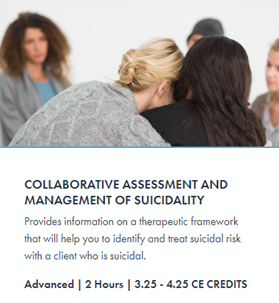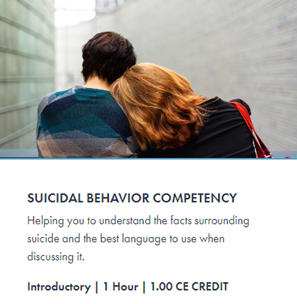Suicidal Ideation: Assessment and Intervention

Forty-five percent of individuals who die by suicide visit their primary care physician within a month before their death and 67% of those who attempt suicide receive medical attention because of their attempt (SAMHSA.gov). Suicidal ideation can present in any healthcare setting. Be aware of suicide risks and warning signs to help prevent suicide. For additional information about suicide prevention within the primary care setting, access the Suicide Prevention Resource Center’s Suicide Prevention Toolkit for Primary Care Practices. The U.S. Department of Veterans Affairs and the Department of Defense (VA/DoD) established a Clinical Practice Guideline for the assessment and management of patients at risk for suicide. The guideline identifies critical decision points in the management of suicide risk behavior and provides clear recommendations on incorporating current information into practice. The guideline is only a tool to assist providers and is not a substitute for clinical judgment.
Assessing for Suicidal Ideation
Ask the member if they feel suicidal or have thoughts of suicide then assess for the following:
Plan- Ask the member if they have a specific plan for how they would hurt themselves.Access- Ask member if they have access to means they could hurt themselves with (weapons, pills, etc.).
Lethality- Assess if the plan is lethal. Is it possible that the member or another person will be harmed?
Warning Signs
- Threatening to kill oneselfTalking of wanting to hurt oneself
- Looking for means to harm self (firearms, pills)
- Talking or writing about death and dying
- Increased risky behavior
- Increased substance use
- Stops taking medication (insulin, blood pressure medications)
- Family history of suicide
- PHQ-9 Score of 15 or higher
- Anxiety, agitation, too much/too little sleep
- Feeling trapped
- Hopelessness
- Withdrawal from friends or family
- Rage, uncontrolled anger
- Dramatic mood change
- Sudden elevation in mood
- Giving away belongings
- Rapid weight loss
- Previous suicide attempts
Interventions and Resources
- When active suicidal ideation presents, contact 911
- Identify your local Psychiatric Evaluation Team through local police or psychiatric hospitals for further assessment
- National Suicide Prevention Hotline (24/7): 1 (800) 273-8255(TALK)
- Crisis Text Line (24/7): Text CONNECT to 741741
- Refer to an in-network mental health provider
- After a crisis, refer the member to Molina Healthcare Case Management for care coordination and additional support
- PsychHub Resources for Providers: Through Molina’s partnership with PsychHub, providers may access a variety of learning hubs and online, digital education resources. To access these resources, go to https://lms.psychhub.com/. Click on “DASHBOARD” and enter the Molina Healthcare Cohort Code for providers: sGDcuXXmQXZEGs
- Suicide Prevention Health Knowledge Platform (Suicide Prevention Resource Center) Home: All courses (healtheknowledge.org)
- The National Zero Suicide Model: Homepage | Zero Suicide (edc.org) Recent Studies found that higher fidelity to practices associated with the Zero Suicide Model was associated with lower instances of suicidal behavior among patients under care at 110 Outpatient Mental Health Clinics. Suicide specific quality improvement activities and lethal means reduction were two essential components of Zero Suicide fidelity along with five other highly effective practices.The Relationship Between Suicidal Behaviors and Zero Suicide Organizational Best Practices in Outpatient Mental Health Clinics | Psychiatric Services (psychiatryonline.org) and Psych News Alert: ‘Zero Suicide’ Practices at Mental Health Clinics Reduce Suicide Among Patients, Study Finds
- Counseling on Access to Lethal Means (CALM) Zero Suicide (edc.org)
- Lethal Means & Suicide Prevention : A Guide for Community & Industry Leaders Lethal Means & Suicide Prevention: A Guide for Community & Industry Leaders | National Action Alliance for Suicide Prevention (theactionalliance.org)
- Preventing Suicide in Emergency Departments Zero Suicide (edc.org)
- Choosing a Suicide Risk Screening Tool RS_suicide screening_91814 final.pdf (sprc.org)
- SAMHSA: Resources for Suicide Prevention Resources for Suicide Prevention | SAMHSA
- Best Practices in Care Transitions for Individuals with Suicide Risk: Inpatient Care to Outpatient Care Best Practices in Care Transitions for Individuals with Suicide Risk: Inpatient Care to Outpatient Care | National Action Alliance for Suicide Prevention (theactionalliance.org)
- Recommended Standard Care for People with Suicide Risk Recommended Standard Care | National Action Alliance for Suicide Prevention (theactionalliance.org)
- Lifeline Online Postvention Manual: LifelineOnlinePostventionManual.pdf (sprc.org)
- The National Institute of Mental Health Ask Suicide-Screening Questions NIMH » Ask Suicide-Screening Questions (ASQ) Toolkit (nih.gov)
- National Institute of Mental Health : Suicide Prevention NIMH » Suicide Prevention (nih.gov)
- SPRC- Choosing a suicide prevention gatekeeper training program: GatekeeperMatrix6-21-18_0.pdf (sprc.org)
4 Key Roles for Providers *Per the Suicide Prevention Resource Center
- Screen and treat or refer for major depressive disorders and substance use disorders.
- Assess and treat for common risk factors: insomnia, chronic pain, severe anxiety, PTSD.
- Educate patients and caregivers on warning signs and resources.
- Teach benefits of safe firearm, ammunition, and medication storage.
Additional Considerations
- Suicide is the 3rd leading cause of death for 15-24 year old Americans (CDC).
- Suicide is the 4th leading cause of death for adults ages 18-65 (CDC).
- Suicide rates for males are highest among those aged 75+ (CDC).
- Suicide rates for females are highest among those aged 45-54 (CDC).
- The most common method of suicide is firearms for males and poisoning for females (CDC).
- For children or adolescent members who have expressed suicidal ideation or suicide attempts, providers are encouraged to engage parents and recommend additional parenting support groups and resources (including, but not limited to, parenting support groups, individual and family counseling, faith- or community-based resources, resources available through school districts, etc.).
PsychHub Education and Learning Available to You
Through our partnership with PsychHub, an online platform for digital mental health education, Molina network providers are able to access PsychHub’s library of educational courses and material at no charge. To create an account at no cost, please visit the Molina PsychHub landing page at https://resources.psychhub.com/molina . Create an account to find these and other relevant courses:



